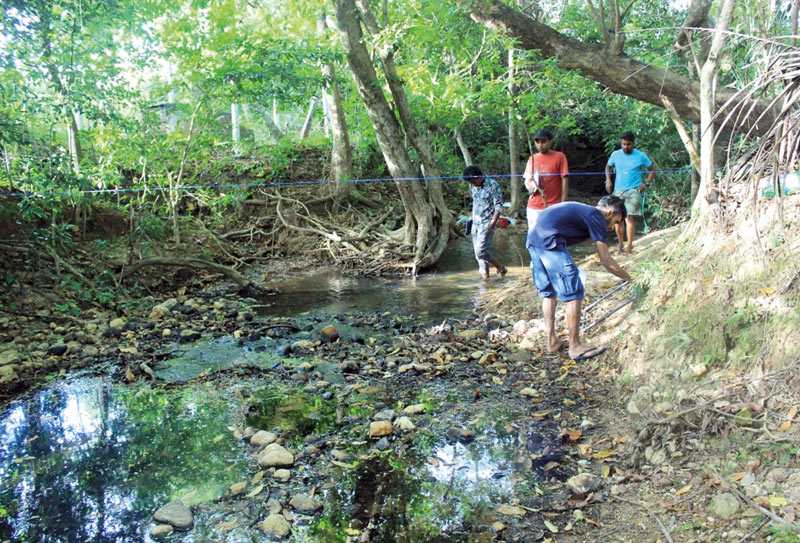Tuesday Dec 16, 2025
Tuesday Dec 16, 2025
Friday, 20 November 2020 01:22 - - {{hitsCtrl.values.hits}}

Sampling at an ephemeral stream
By Dr. Ayantha Gomes
|
A dried up ephemeral streambed
|
Streams can be defined as flowing water bodies, confined within a channel and moving in one direction, and their flow can vary depending on climate and season changes. In regard to variation of flow, streams can be classified into two main categories, namely perennial and non-perennial.
Perennial streams flow without break throughout the year and non-perennial streams will have recurring periods of flowing and drying of water. These non-perennial streams are further classified into ephemeral, intermittent, episodic and seasonal, without major differences within their characteristics.
Collectively referred to as ephemeral streams as a commonly used term, they undergo “flow cessation”, where surface flow ceases, pools are formed and eventually completely dry exposing the streambed, based on environmental conditions.
In many parts of the world, most of the stream segments are ephemeral, and they consist of more than half of the world’s river networks. Due to climate change, perennial streams are at a risk of turning into ephemeral streams, and therefore, studies involving these streams are very important in the context of water resource management.
Merely disregarded as surface flow only a few decades back, these streams have many important functions ranging from contribution to connectivity of the river networks, maintenance of water quality in downstream rivers, to being a viable source of water that is much needed in the current world of increasing freshwater demand.
An interesting characteristic of ephemeral streams is that they are aquatic and terrestrial ecosystems that are can vary with time and place due to the flowing and drying cycles of these streams. These ecosystems can vary along the length of the river as well, and can expand and contract in response to the changing flow of the streams, prompting adaptations from the flora and fauna in these habitats.
Ephemeral streams are in a unique position to intercept and process nutrients and sediments flowing into major rivers, as these streams are mostly headwater streams that carry water from the upper reaches into the more significant perennial streams.
Along perennial streams, water is utilised for domestic purposes, which indirectly make ephemeral streams crucial when considering water quality of perennials, as their chemical constituents can end up in the food chain.
Furthermore, aquatic life will be affected with the condition of the water of both types of streams. Ephemeral streams also contribute to groundwater recharge by way of infiltration, where rainwater transfers downward into the soil, and can be the only source of water replenishment in dry regions. The high infiltration rates of ephemeral streams also help in flood control, where the rapid transfer of water into soil prevents overflow and flooding of surface water.
The field experiments done by researchers of Sri Lanka Institute of Information Technology in Ephemeral streams in Balangoda, Minneriya, Puttlam and Wellwaya observed excessively high infiltration in ephemeral stream dry beds. In fact, some of the values were as high as infiltration rates of porous concrete that is used in sustainable urban drainage designs.
This is good field-based evidence that any regulation in ephemeral streams could be disastrous with respect to flood control and groundwater recharge. No ephemeral streams can be seen in urban areas, and perhaps, reclaimed ephemerals could be one reason of urban flooding.
Ephemeral streams, like other freshwater systems, have impact from human activities, specifically to the timing of flow, flow volume, surface and ground water, habitats and ecological processes. The only difference between ephemeral and other streams, is that due to the disregard for these streams, the impacts of human activities and subsequent effects are studied much less.
Human impact, coupled together with climate change cause unpredictable flows and water quality in ephemeral streams, jeopardising the ecological value of these streams and their ecosystems. With rapid urbanisation, modifications are frequently made to waterways such as changes to landscape and physical characteristics of streams.
Extreme modifications such as concreting of waterways, burying or filling of ephemeral streams etc. can have negative effects on these waterways, disrupting their natural processes and hindering their potential uses. The studies we have done so far are therefore proven crucial, for uses in sustainability and water resource management, in addition to justification of rehabilitation and conservation.
It is expected for the results to be forwarded to relevant Government agencies to introduce much needed legislative protection for ephemeral streams. This is vital as most conservation rules and regulations do not comprehensively cover ephemeral streams.
(The writer is attached to the Sri Lanka Institute of Information Technology, Malabe, and is a senior lecturer and a charted civil engineer.)